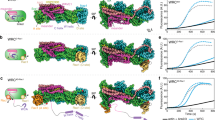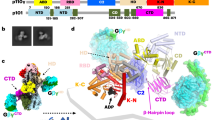Abstract
Despite having a high degree of sequence similarity, the Rho guanosine triphosphatases Rac1 and Rac2 regulate distinct functions in neutrophils. Here we demonstrate that the unique Rac2 localization and functions in neutrophils are regulated by two separate C-terminal motifs, the hypervariable domain and aspartic acid 150, one of which has not previously been linked to the function of Rho GTPases. In addition, we show an unexpected dependence of Rac1 localization on Rac2 activity in these same cells, demonstrating a degree of crosstalk between two closely related Rho GTPases. Thus, we have defined specific sequences in Rac that specify subcellular localization and determine the specificity of Rac2 in neutrophil chemotaxis and superoxide generation.
This is a preview of subscription content, access via your institution
Access options
Subscribe to this journal
Receive 12 print issues and online access
$209.00 per year
only $17.42 per issue
Buy this article
- Purchase on Springer Link
- Instant access to full article PDF
Prices may be subject to local taxes which are calculated during checkout







Similar content being viewed by others
References
Lim, L., Manser, E., Leung, T. & Hall, C. Regulation of phosphorylation pathways by p21 GTPases. The p21 Ras-related Rho subfamily and its role in phosphorylation signalling pathways. Eur. J. Biochem. 242, 171–185 (1996).
Van Aelst, L. & D'Souza-Schorey, C. Rho GTPases and signaling networks. Genes Dev. 11, 2295–2322 (1997).
Hall, A. G proteins and small GTPases: distant relatives keep in touch. Science 280, 2074–2075 (1998).
Didsbury, J., Weber, R.F., Bokosh, G.M., Evans, T. & Synderman, R. Rac, a novel ras-related family of proteins that are botulinum toxin substrates. J. Biol. Chem. 264, 16378–16382 (1989).
Moll, J., Sansig, G., Fattori, E. & van der Putten, H. The murine rac1 gene: cDNA cloning, tissue distribution and regulated expression of rac1 mRNA by disassembly of actin microfilaments. Oncogene 6, 863–866 (1991).
Shirsat, N.V., Pignolo, R.J., Kreider, B.L. & Rovera, G. A member of the ras gene superfamily is expressed specifically in T, B and myeloid hemopoietic cells. Oncogene 5, 769–772 (1990).
Haataja, L., Groffen, J. & Heisterkamp, N. Characterization of RAC3, a novel member of the Rho family. J. Biol. Chem. 272, 20384–20388 (1997).
Gu, Y. et al. Hematopoietic cell regulation by Rac1 and Rac2 guanosine triphosphatases. Science 302, 445–449 (2003).
Glogauer, M. et al. Rac1 deletion in mouse neutrophils has selective effects on neutrophil functions. J. Immunol. 170, 5652–5657 (2003).
Li, S. et al. Chemoattractant-stimulated Rac activation in wild-type and Rac2-deficient murine neutrophils: preferential activation of Rac2 and Rac2 gene dosage effect on neutrophil functions. J. Immunol. 169, 5043–5051 (2002).
Roberts, A.W. et al. Deficiency of the hematopoietic cell-specific Rho family GTPase Rac2 is characterized by abnormalities in neutrophil function and host defense. Immunity 10, 183–196. (1999).
Williams, D.A. et al. Dominant negative mutation of the hematopoietic-specific RhoGTPase, Rac 2, is associated with a human phagocyte immunodeficiency. Blood 96, 1646–1654 (2000).
Ambruso, D.R. et al. Human neutrophil immunodeficiency syndrome is associated with an inhibitory Rac2 mutation. Proc. Natl. Acad. Sci. USA 97, 4654–4659 (2000).
Diekmann, D., Nobes, C.D., Burbelo, P.D., Abo, A. & Hall, A. Rac GTPase interacts with GAPs and target proteins through multiple effector sites. EMBO J. 14, 5297–5305 (1995).
Zhang, F.L. & Casey, P.J. Protein prenylation: molecular mechanisms and functional consequences. Annu. Rev. Biochem. 65, 241–269 (1996).
Gelb, M.H., Scholten, J.D. & Sebolt-Leopold, J.S. Protein prenylation: from discovery to prospects for cancer treatment. Curr. Opin. Chem. Biol. 2, 40–48 (1998).
Tao, W. et al. The TRQQKRP motif located near the C-terminus of Rac2 is essential for Rac2 biologic functions and intracellular localization. Blood 100, 1679–1688 (2002).
Michaelson, D. et al. Differential localization of Rho GTPases in live cells: regulation by hypervariable regions and RhoGDI binding. J. Cell. Biol. 152, 111–126 (2001).
Benard, V., Bohl, B.P. & Bokoch, G.M. Characterization of Rac and Cdc42 activation in chemoattractant-stimulated human neutrophils using a novel assay for active GTPases. J. Biol. Chem. 274, 13198–13204 (1999).
Joseph, G., Gorzalczany, Y., Koshkin, V. & Pick, E. Inhibition of NADPH oxidase activation by synthetic peptides mapping within the carboxyl-terminal domain of small GTP-binding proteins. Lack of amino acid sequence specificity and importance of polybasic motif. J. Biol. Chem. 269, 29024–29031 (1994).
Gardiner, E.M. et al. Spatial and temporal analysis of Rac activation during live neutrophil chemotaxis. Curr. Biol. 12, 2029–2034 (2002).
Li, J.M. & Shah, A.M. Intracellular localization and preassembly of the NADPH oxidase complex in cultured endothelial cells. J. Biol. Chem. 277, 19952–19960 (2002).
Scheffzek, K., Stephan, I., Jensen, O.N., Illenberger, D. & Gierschik, P. The Rac-RhoGDI complex and the structural basis for the regulation of Rho proteins by RhoGDI. Nat. Struct. Biol. 7, 122–126 (2000).
Grizot, S. et al. Crystal structure of the Rac1-RhoGDI complex involved in nadph oxidase activation. Biochemistry 40, 1000–10013 (2001).
Dib, K. et al. Down-regulation of Rac activity during β2 integrin-mediated adhesion of human neutrophils. J. Biol. Chem. 278, 24181–24188 (2003).
Hoffman, G.R., Nassar, N. & Cerione, R.A. Structure of the Rho family GTP-binding protein Cdc42 in complex with the multifunctional regulator RhoGDI. Cell 100, 345–356 (2000).
Roy, M.O., Leventis, R. & Silvius, J.R. Mutational and biochemical analysis of plasma membrane targeting mediated by the farnesylated, polybasic carboxy terminus of K-ras4B. Biochemistry 39, 8298–8307 (2000).
Apolloni, A., Prior, I.A., Lindsay, M., Parton, R.G. & Hancock, J.F. H-ras but not K-ras traffics to the plasma membrane through the exocytic pathway. Mol. Cell. Biol. 20, 2475–2487 (2000).
Dong, X. et al. Palmitoylation and plasma membrane localization of Ras2p by a nonclassical trafficking pathway in Saccharomyces cerevisiae. Mol. Cell. Biol. 23, 6574–6584 (2003).
Knaus, U.G., Wang, Y., Reilly, A.M., Warnock, D. & Jackson, J.H. Structural requirements for PAK activation by Rac GTPases. J. Biol. Chem. 273, 21512–21518 (1998).
Van Hennik, P.B. et al. The C-terminal domain of Rac1 contains two motifs that control targeting and signaling specificity. J. Biol. Chem. 278, 39166–39175 (2003).
Servant, G. et al. Polarization of chemoattractant receptor signaling during neutrophil chemotaxis. Science 287, 1037–1940. (2000).
Weiner, O.D. et al. A PtdInsP(3)- and Rho GTPase-mediated positive feedback loop regulates neutrophil polarity. Nat. Cell. Biol. 4, 509–513 (2002).
Wang, F. et al. Lipid products of PI(3)Ks maintain persistent cell polarity and directed motility in neutrophils. Nat. Cell. Biol. 4, 513–518 (2002).
Srinivasan, S. et al. Rac and Cdc42 play distinct roles in regulating PI(3,4,5)P3 and polarity during neutrophil chemotaxis. J. Cell. Biol. 160, 375–385 (2003).
Yang, F.C. et al. Rac 2 stimulates Akt activation affecting BAD/Bcl-XL expression while mediating survival and actin-based cell functions in primary mast cells. Immunity 12, 557–568 (2000).
Jackson, J.H. et al. Farnesol modification of Kirsten-ras exon 4B protein is essential for transformation. Proc. Natl. Acad. Sci. USA 87, 3042–3046 (1990).
Acknowledgements
We thank J. Robbins and H. Osinska for help with confocal analysis; D. Marmer and the Flow Cytometry Core at Cincinnati Children's Hospital Medical Center for assistance with cell sorting; S. Homan and V. Summey-Harner for animal husbandry; and S. Wheeler and K. Steward for administrative assistance. Supported by National Institutes of Health (RO1 DK62757 to D.A.W.).
Author information
Authors and Affiliations
Corresponding author
Ethics declarations
Competing interests
The authors declare no competing financial interests.
Supplementary information
Supplementary Fig. 1
Confocal microscopy analysis of Rac mutant localization 15 sec after fMLP stimulation as compared with plasma membrane localization. (PDF 1401 kb)
Supplementary Table 1
Specificity of Rac2 functions is correlated with its subcellular distribution. (PDF 16 kb)
Rights and permissions
About this article
Cite this article
Filippi, MD., Harris, C., Meller, J. et al. Localization of Rac2 via the C terminus and aspartic acid 150 specifies superoxide generation, actin polarity and chemotaxis in neutrophils. Nat Immunol 5, 744–751 (2004). https://doi.org/10.1038/ni1081
Received:
Accepted:
Published:
Issue Date:
DOI: https://doi.org/10.1038/ni1081
This article is cited by
-
Combined Immunodeficiency Caused by a Novel De Novo Gain-of-Function RAC2 Mutation
Journal of Clinical Immunology (2022)
-
Neutrophil recruitment limited by high-affinity bent β2 integrin binding ligand in cis
Nature Communications (2016)
-
Glutamate induces neutrophil cell migration by activating class I metabotropic glutamate receptors
Amino Acids (2013)
-
AKT-mediated regulation of polarization in differentiated human neutrophil-like HL-60 cells
Inflammation Research (2012)
-
Glutamate is the chemotaxis-inducing factor in placental extracts
Amino Acids (2009)



